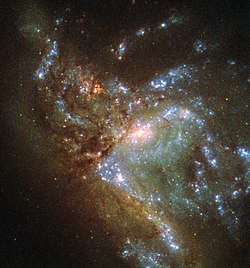NGC 6052
NGC 6052 is a pair of galaxies in the constellation of Hercules.[2] It was discovered on 11 June 1784 by William Herschel.[4] It was described as "faint, pretty large, irregularly round" by John Louis Emil Dreyer, the compiler of the New General Catalogue.[4]
| NGC 6052 | |
|---|---|
 Hubble image of NGC 6052 | |
| Observation data (J2000 epoch) | |
| Constellation | Hercules |
| Right ascension | 16h 05m 12.880s[1] |
| Declination | +20° 32′ 32.61″[1] |
| Redshift | 0.015808[2] |
| Helio radial velocity | 4739 km/s[2] |
| Distance | 399.05 ± 110.83 Mly (122.350 ± 33.980 Mpc)[2] |
| Apparent magnitude (V) | 13.00[3] |
| Apparent magnitude (B) | 13.44[3] |
| Characteristics | |
| Type | Sc[2] |
| Size | 110,900 ly (33,990 pc)[2][note 1] |
| Apparent size (V) | 0.9′ × 0.7′[2] |
| Other designations | |
| NGC 6064, Arp 209, UGC 10182, MGC+04-38-022, PGC 57039[3] | |
The two components of NGC 6052 are designated NGC 6052A and NGC 6052B, respectively. The two, attracted by each other's gravity, have collided and are interacting with each other. NGC 6052 is currently in a late stage of merging, where the shape of the two galaxies is not distinctly defined.[5]
SN 1982aa, a powerful radio supernova, was detected in NGC 6052.[6]
Gallery
gollark: The word for something which works without you knowing why is a "black box".
gollark: No, lambda calculus is just working on abstract lambda thingies, it's a simple model for computation which is also kind of useless.
gollark: Meanwhile, GPT-3, OpenAI's latest GPT text generation thing, has *175 billion* parameters and uses, what, tens of gigabytes of memory?
gollark: No, lambda calculus is a relatively simple model you can understand fairly easily.
gollark: And with neural networks, you don't actually know *how* the network does its job, just that you feed in pixels and somehow get classification data out.
References
- Skrutskie, M. (2006). "The Two Micron All Sky Survey (2MASS)". The Astronomical Journal. 131 (2): 1163–1183. Bibcode:2006AJ....131.1163S. doi:10.1086/498708.
- "NED results for object NGC 6052". National Aeronautics and Space Administration / Infrared Processing and Analysis Center. Retrieved 24 November 2017.
- "NGC 6052". SIMBAD. Centre de données astronomiques de Strasbourg. Retrieved 24 November 2017.
- "New General Catalog Objects: NGC 6050 - 6099". cseligman.com. Retrieved 24 November 2017.
- Schmidt, Judy. "Two become one". Hubble Space Telescope. ESA/Hubble & NASA. Retrieved 2016-01-05.
- Yin, Q. F. (1991). "IAUC 5276: NGC 6052; 1991b; 1989h1" (5276). IAU Circular. Cite journal requires
|journal=(help) - "Colliding galaxies". www.spacetelescope.org. Retrieved 4 March 2019.
Notes
- RC3 D0 (blue) values used.
This article is issued from Wikipedia. The text is licensed under Creative Commons - Attribution - Sharealike. Additional terms may apply for the media files.
